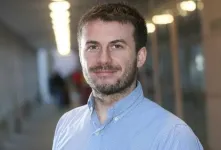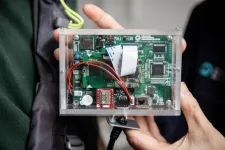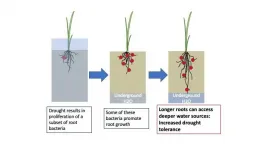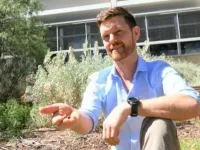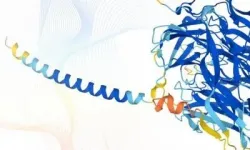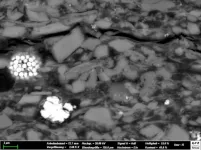(Press-News.org) Geneticists from Trinity College Dublin have discovered how a specific genetic mutation called H3K27M causes a devastating, incurable childhood cancer, known as diffuse midline glioma (DMG), and - in lab studies working with model cell types - successfully reverse its effects to slow cancer cell growth with a targeted drug.
Their landmark work - just published in leading international journal, Nature Genetics and supported by Worldwide Cancer Research and The Brain Tumour Charity - translates crucial new understanding of the genetics of DMG progression into a highly promising, targeted therapeutic approach and offers significant hope of improved treatments in the future.
The scientists now call for clinical trials to begin imminently, in which an already approved class of drugs called "EZH2 inhibitors" can be assessed. These drugs target the same key biological pathway involved in DMG as they do successfully in lymphomas and sarcomas -- two cancers common in adults.
Key findings and implications
The scientists behind this important work discovered:
How a specific genetic mutation called H3K27M causes DMG
How to target this cancer-causing gene with a drug that slows cancer cell growth
They have also established a specific model cell line for evaluating further targeted DMG approaches
Adrian Bracken, Professor in Trinity's School of Genetics and Microbiology, led the exciting research.
He said: "We've taken a huge step forward in our study of DMG tumours and hope that the insights will help us design and implement precision oncology-based treatment approaches in DMG patients in the future. Crucially, 'EZH2 inhibitor' drugs have already received approval from the United States Food and Drug Administration for the treatment of two types of adult cancer. We propose these drugs could be impactful for children with DMG and, as a result, call for clinical trials to begin next.
"Ultimately, we hope that our work - together with that of others focused in this area - will lead to curative clinical approaches for what is a truly terrible disease that can devastate families and for which there are currently no therapeutic options."
Paediatric gliomas - harrowing, devastating cancers
Paediatric gliomas like DMG are among the most devastating of childhood cancers. Tumours typically arise in the brain and are very challenging to treat, with prognosis extremely poor. As such, effective therapeutic options are urgently needed.
Dr Jane Pears, paediatric consultant oncologist at Our Lady's Children's Hospital, Crumlin, who treats children with this disease said: "Despite combined best efforts, these tumours remain a devastating diagnosis for children and their families. The best treatment we can currently offer may extend survival for a few months but is not curative. We are now entering an exciting era of expansion of our knowledge of this disease at a molecular level, which in turn will lead us towards more targeted treatments. Thanks to collaborative translational efforts between scientists, such as Prof. Bracken and his team working in the laboratory, and doctors in the clinical setting, this will hopefully lead to the improved outcomes that we all so dearly wish to see."
Speaking to the importance of the work, Maeve Lowery, Professor of Translational Cancer Medicine at Trinity, and Academic Director of the Trinity St James's Cancer Institute (TSJCI) said: "These findings have the potential to transform the treatment landscape of DMG tumours and improve outcomes for children with this challenging disease. Importantly, this pivotal work illustrates the success of a precision oncology approach - where understanding how cancers develop on a genomic level can accelerate the development of more effective treatments with less side effects. The Precision Oncology Research Program at TSJCI, led by Prof Bracken, will build on this success to continue to develop new and innovative treatment strategies for adult and childhood cancers."
Dr Becky Birch, Head of Research at The Brain Tumour Charity, which helped fund the study, said: "This is a really promising discovery that we hope will now pave the way for new and targeted treatments to be developed for children with diffuse midline gliomas (DMGs). With average survival still heartbreakingly short at less than 12 months, we urgently need to find new options to help slow the growth of this rare and often-inoperable cancer and give children diagnosed more time to live. It's really exciting that we now better understand how a specific genetic mutation may be driving the disease, and even more so that drugs that may inhibit this process have already been tested in other cancers. If further research can now design EZH2 inhibitors to more effectively target DMG cells, we hope these drugs can be quickly advanced into clinical trials for children diagnosed with this devastating disease."
Developing cancer treatments - why this research is different
Ordinarily, developing effective cancer treatments can take decades; indeed, it can take years before scientists are able to develop model systems in relevant cell types that afford them the chance to "look under the genetic bonnet".
Such investigations can first help us understand how cancers function. That information then provides the all-important clues as to how we can fight them. Further lab-based studies can hone these approaches, ultimately opening the doors to clinical trials and, if we're lucky, improved treatments.
The scientists behind this study have therefore taken great strides in the battle against DMG, having discovered key aspects of this disease at a genetic level; proposed an available strategy to target it; and created a model of the disease that can be used in continued work to advance further improved treatment strategies.
INFORMATION:
A form of gene therapy protects optic nerve cells and preserves vision in mouse models of glaucoma, according to research supported by NIH's National Eye Institute. The findings suggest a way forward for developing neuroprotective therapies for glaucoma, a leading cause of visual impairment and blindness. The report was published in Cell.
Glaucoma results from irreversible neurodegeneration of the optic nerve, the bundle of axons from retinal ganglion cells that transmits signals from the eye to the brain to produce vision. Available therapies slow vision loss by lowering elevated eye pressure, however some glaucoma progresses to blindness despite normal eye pressure. Neuroprotective therapies would be a leap forward, meeting ...
Advances in microscopy have enabled researchers to picture loops of DNA strands for the first time. The images reveal how the human genome organises itself in three-dimensional space at much higher resolution than previously possible.
The findings, published in a new study in the journal Molecular Cell, also reveal that the process of DNA being copied into RNA - transcription - indirectly shapes the architecture of the genome. An international team led by Pia Cosma at the Centre for Genomic Regulation (CRG) in Barcelona and Melike Lakadamyali at the Perelman ...
Manipulating RNA can allow plants to yield dramatically more crops, as well as increasing drought tolerance, announced a group of scientists from the University of Chicago, Peking University and Guizhou University.
In initial tests, adding a gene encoding for a protein called FTO to both rice and potato plants increased their yield by 50% in field tests. The plants grew significantly larger, produced longer root systems and were better able to tolerate drought stress. Analysis also showed that the plants had increased their rate of photosynthesis.
"The change really is dramatic," said University of Chicago Prof. Chuan He, who together with Prof. Guifang Jia at Peking University, led ...
A new study showed that a wearable computer vision device can reduce collisions for both people who are blind or those who are visually impaired and using a long cane and/or guide dog by 37 percent, compared to using other mobility aids alone.
People who have visual impairments are at a significantly higher risk for collisions and falls. Commonly used mobility aids like long canes and guide dogs can offer benefits, but come with limitations in effectiveness and costs, respectively. While some electronic devices are marketed direct-to-consumer claiming to warn wearers of surrounding objects, there has been little evidence of their effectiveness in actual daily mobility settings. This is one of the first randomized-controlled trials to look at the potential benefit of the ...
What The Study Did: This study included 647 patients with untreated nonmetastatic prostate cancer (269 patients during the pandemic and 378 from before the pandemic). During the initial COVID-19 lockdown, only 1% of Black men underwent prostatectomy, while 26% of white patients did. Prior to the pandemic, there was no difference in the rate of prostatectomy between the two races (18% of Black men and 19% of white men). The lessons from this study suggest systemic inequities within health care and are likely applicable across medical specialties. Public health efforts are needed to fully recognize the unintended consequence of diversion of cancer resources to the COVID-19 pandemic to develop balanced mitigation strategies as viral rates continue to fluctuate.
Authors: ...
Drought can have a lasting impact on the community of microbes that live in and around roots of rice plants, a team led by UC Davis researchers has found. Root-associated microbes help plants take up nutrients from the soil, so the finding could help in understanding how rice responds to dry spells and how it can be made more resilient to drought. The work is published July 22 in Nature Plants.
The root microbiome of irrigated rice plants goes through a sequence of changes as the plants grow and stabilizes when they flower. The sequence of changes in the root ...
Restoration of degraded drylands is urgently needed to mitigate climate change, reverse desertification and secure livelihoods for the two billion people who live there, experts warn in a major new paper in Nature Ecology & Evolution.
Scientists leading the Global Arid Zone Project examined restoration seeding outcomes at 174 sites on six continents, encompassing 594,065 observations of 671 plant species - with the lessons learned important to meeting ambitious future restoration targets.
Flinders University Dr Martin Breed, one of three Australian researchers who helped coordinate ...
LONDON, 22 July 2021 - DeepMind today announced its partnership with the European Molecular Biology Laboratory (EMBL), Europe's flagship laboratory for the life sciences, to make the most complete and accurate database yet of predicted protein structure models for the human proteome. This will cover all ~20,000 proteins expressed by the human genome, and the data will be freely and openly available to the scientific community. The database and artificial intelligence system provide structural biologists with powerful new tools for examining a protein's three-dimensional structure, and offer a treasure trove of data that could unlock future advances and herald a new era for AI-enabled biology.
AlphaFold's recognition in December 2020 by the ...
Newly-hatched pterosaurs may have been able to fly but their flying abilities may have been different from adult pterosaurs, according to a new study.
Pterosaurs were a group of flying reptiles that lived during the Triassic, Jurassic and Cretaceous Periods (228 to 66 million years ago). Due to the rarity of fossilised pterosaur eggs and embryos, and difficulties distinguishing between hatchlings and small adults, it has been unclear whether newly-hatched pterosaurs were able to fly.
Researchers from the Universities of Portsmouth and Bristol, along with palaeontologist Darren Naish, found that hatchling humerus bones were stronger than those of many adult pterosaurs, indicating ...
The Alum Shale of Northern Europe not only has an eventful history of formation, connected with the microcontinent Baltica, it also holds great potential as an object of investigation for future research questions. Geologists use the rock to reconstruct processes of oil and gas formation, and even possible traces of past life on Mars can be identified with its help. Researchers at the German Research Centre for Geosciences Potsdam GFZ, together with colleagues from Canada, China, Switzerland and Denmark, have summarised the state of knowledge about the multi-layered rock. Their article was published in July in the journal Earth-Science Reviews.
The Microcontinent Baltica
"This rock tells a story," says Hans-Martin Schulz when he talks about the Northern European Alum Shale. It is ...
